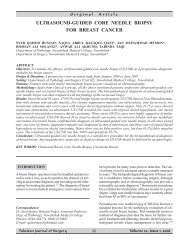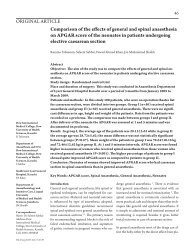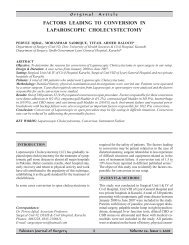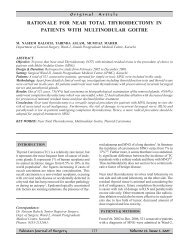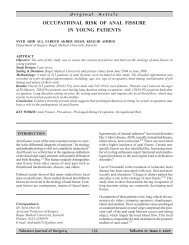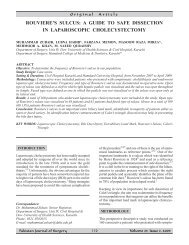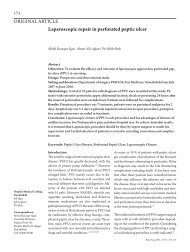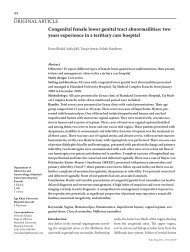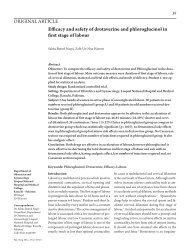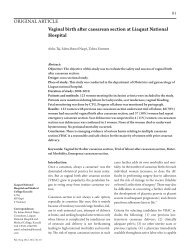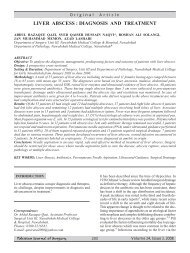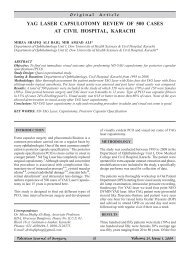Prognostic factors in Typhoid Enteric Perforation - Pakistan Journal ...
Prognostic factors in Typhoid Enteric Perforation - Pakistan Journal ...
Prognostic factors in Typhoid Enteric Perforation - Pakistan Journal ...
You also want an ePaper? Increase the reach of your titles
YUMPU automatically turns print PDFs into web optimized ePapers that Google loves.
Orig<strong>in</strong>al<br />
Article<br />
PROGNOSTIC FACTORS IN TYPHOID<br />
ENTERIC PERFORATION<br />
MUHAMMAD LAIQ-UZ-ZAMAN KHAN, SHAMS NADEEM ALAM, JAHANZAIB HAIDER,<br />
KHALID AHSAN MALIK<br />
Department of Surgery, Unit VI, Dow University of Health Sciences & Civil Hospital, Karachi<br />
ABSTRACT<br />
Objective: To analyze and predict the significance of various <strong>factors</strong> on the outcome <strong>in</strong> typhoid enteric perforation<br />
<strong>in</strong> a Surgical Unit of Teach<strong>in</strong>g Hospital <strong>in</strong> Karachi.<br />
Study Design: Case series.<br />
Sett<strong>in</strong>g & Duration: Surgical Unit II and VI of Civil Hospital Karachi from March 2007 to February 2009.<br />
Methodology: This study was conducted <strong>in</strong> sixty two consecutive patients cl<strong>in</strong>ically diagnosed as hav<strong>in</strong>g typhoid<br />
perforation were <strong>in</strong>cluded <strong>in</strong> this study. Diagnosis was ma<strong>in</strong>ly cl<strong>in</strong>ical and supplemented by Widal test, radiological<br />
f<strong>in</strong>d<strong>in</strong>gs of free gas under diaphragm, per operative f<strong>in</strong>d<strong>in</strong>gs of ileal perforation on anti mesenteric border. All the<br />
patients had exploratory laparotomy after adequate resuscitation. Operative f<strong>in</strong>d<strong>in</strong>gs were noted, and the amount<br />
of pus and fecal material dra<strong>in</strong>ed were estimated, and perforation was exteriorized as ileostomy. The postoperative<br />
outcome was closely monitored, and the data on each patient were entered <strong>in</strong>to a proforma.<br />
Results: Fifty (80%) patients were males and twelve (20%) patients were females. Fifty two (84%) patients had s<strong>in</strong>gle<br />
perforation while ten (16%) patients had multiple perforations. Fifty (80%) patients developed various postoperative<br />
complications, <strong>in</strong> which <strong>in</strong>cluded wound <strong>in</strong>fection, burst abdomen, residual <strong>in</strong>tra-abdom<strong>in</strong>al abscess, septicemia and<br />
fecal fistula. The age and sex had no effect on the prognosis. Late presentation, delay <strong>in</strong> operation, multiple<br />
perforations, and dra<strong>in</strong>age of copious quantities of pus and fecal material from the peritoneal cavity adversely<br />
affected the mortality rate. Overall mortality rate was 17.7% (11/62).<br />
Conclusion: Mortality <strong>in</strong> typhoid perforation is significantly affected by duration of illness, perforation-operation<br />
<strong>in</strong>terval, multiple perforations, copious peritoneal fluid, septicemia, fecal fistula and burst abdomen; and some of<br />
the survivors with fecal fistula, wound <strong>in</strong>fection and wound dehiscence are faced with prolonged hospital stay.<br />
KEY WORDS: <strong>Enteric</strong> <strong>Perforation</strong>, Mortality, <strong>Prognostic</strong> Factors, <strong>Typhoid</strong><br />
INTRODUCTION<br />
<strong>Perforation</strong> of the bowel is the most serious complication<br />
of typhoid fever. The result<strong>in</strong>g peritonitis <strong>in</strong> such a<br />
seriously ill patient may be rapidly fatal unless it is<br />
treated promptly and vigorously. These patients constitute<br />
a difficult therapeutic problem, and surgery, although<br />
associated with a high morbidity and mortality, offers<br />
Correspondence:<br />
Dr. Laiq-uz-Zaman Khan, Senior Registrar,<br />
Department of Surgery, Unit VI,<br />
Dow University of Health Sciences &<br />
Civil Hospital, Karachi.<br />
Phones: 0333-2276368.<br />
E-mail: drlaiq@yahoo.co.uk<br />
the greatest hope of survival. 1 Nowadays, this mortality<br />
rate, although decreas<strong>in</strong>g but still rema<strong>in</strong>s very high,<br />
rang<strong>in</strong>g from 1 to 39% 2 , with a significant morbidity<br />
rate <strong>in</strong> spite of therapeutic progress. The mortality rate<br />
could be improved with the use of better supportive<br />
care, <strong>in</strong>clud<strong>in</strong>g parenteral nutrition and <strong>in</strong>vasive monitor<strong>in</strong>g.<br />
Such measures are beyond the reach of many<br />
hospitals <strong>in</strong> the develop<strong>in</strong>g world and management<br />
rema<strong>in</strong>s difficult <strong>in</strong> develop<strong>in</strong>g countries, which are<br />
frequently located <strong>in</strong> typhoid endemic areas such as<br />
<strong>Pakistan</strong>, India, South America and Africa. 3 Various<br />
<strong>factors</strong> affect the prognosis and outcome of surgical<br />
treatment such as delayed presentation, <strong>in</strong>adequate preoperative<br />
resuscitation, delay <strong>in</strong> surgery, number of<br />
perforations and degree of fecal contam<strong>in</strong>ation. 4-6<br />
Intest<strong>in</strong>al perforation from typhoid fever is an extensive<br />
and cont<strong>in</strong>u<strong>in</strong>g disease and should not be handled like<br />
a localized or limited perforation such as perforated<br />
ulcer, appendicitis or trauma. 7<br />
101<br />
Volume 25, Issue 2, 2009
<strong>Prognostic</strong> Factors <strong>in</strong> Thyphoid <strong>Enteric</strong> <strong>Perforation</strong><br />
This study was carried out to analyze and predict the<br />
significance of various <strong>factors</strong> on the outcome <strong>in</strong> typhoid<br />
enteric perforation <strong>in</strong> a Surgical Unit of teach<strong>in</strong>g hospital<br />
<strong>in</strong> Karachi and to compare our f<strong>in</strong>d<strong>in</strong>gs to that of other<br />
parts of the world. The identification of the outcome<br />
<strong>factors</strong> will help <strong>in</strong> decision mak<strong>in</strong>g, prioritiz<strong>in</strong>g management<br />
and improv<strong>in</strong>g the quality of care.<br />
METHODOLOGY<br />
This study was done on sixty two consecutive patients<br />
with typhoid ileal perforation were admitted <strong>in</strong> the<br />
Surgical Unit II and VI of Civil Hospital, Karachi dur<strong>in</strong>g<br />
the period of two years from March 2007 to February<br />
2009. All patients were above the age of 12 and ranged<br />
up to 60 years. S<strong>in</strong>ce typhoid fever is endemic <strong>in</strong> this<br />
region, for all practical purposes it was assumed that<br />
patients with a fever of 1-3 weeks duration who developed<br />
a cl<strong>in</strong>ical picture consistent with <strong>in</strong>test<strong>in</strong>al perforation<br />
were cases of typhoid enteric perforation. Diagnosis<br />
was ma<strong>in</strong>ly cl<strong>in</strong>ical and supplemented by Widal test,<br />
radiological f<strong>in</strong>d<strong>in</strong>gs of free gas under diaphragm, per<br />
operative f<strong>in</strong>d<strong>in</strong>gs of ileal perforation on anti mesenteric<br />
border and an acutely <strong>in</strong>flamed and edematous term<strong>in</strong>al<br />
ileum. Traumatic perforation was excluded by the absence<br />
of a history of trauma; tubercular perforations were<br />
excluded by typical operative f<strong>in</strong>d<strong>in</strong>gs and biopsy.<br />
<strong>Perforation</strong> was heralded by exacerbation of abdom<strong>in</strong>al<br />
pa<strong>in</strong> associated with tenderness, rigidity and guard<strong>in</strong>g,<br />
most pronounced over right iliac fossa, however for<br />
some patients <strong>in</strong> a severe toxic state, these signs were<br />
obscured with resultant delay <strong>in</strong> diagnosis and adequate<br />
surgical <strong>in</strong>tervention.<br />
All patient was resuscitated before operation for 12 to<br />
24 hours until the circulatory volume was restored and<br />
the patients had exploratory laparotomy after adequate<br />
resuscitation. Operative f<strong>in</strong>d<strong>in</strong>gs were noted, and the<br />
volume of pus and fecal material dra<strong>in</strong>ed were estimated.<br />
The edge of the ileal perforation was excised along<br />
with mesenteric lymph node for histopathology, and<br />
perforation was exteriorized as ileostomy. In case of<br />
multiple perforations distal perforation primarily closed<br />
while proximal exteriorized. Copious peritoneal lavage<br />
was done with warm sal<strong>in</strong>e, with a dra<strong>in</strong> <strong>in</strong> the pelvis,<br />
and mass closure of the abdomen was done.<br />
The postoperative outcome was closely monitored, and<br />
the data on each patient were entered <strong>in</strong>to a pro forma<br />
prepared for the study. All data were analyzed us<strong>in</strong>g<br />
Fisher Exact test to determ<strong>in</strong>e the <strong>in</strong>fluence of the studied<br />
variables on the outcome. The differences were<br />
taken as significant only if the p-value is
<strong>Prognostic</strong> Factors <strong>in</strong> Thyphoid <strong>Enteric</strong> <strong>Perforation</strong><br />
M. L. Khan, S. N. Alam, et al<br />
Complications<br />
S<strong>in</strong>gle<br />
<strong>Perforation</strong><br />
Multiple<br />
<strong>Perforation</strong><br />
DF<br />
Fisher Exact Test<br />
(P-Value)<br />
Wound Infection<br />
Burst Abdomen<br />
Residual Abscess<br />
Septicemia<br />
Fecal Fistula<br />
Death<br />
Total No. of Patients<br />
40<br />
18<br />
5<br />
6<br />
2<br />
4<br />
52<br />
10<br />
6<br />
2<br />
8<br />
3<br />
7<br />
10<br />
1<br />
1<br />
1<br />
1<br />
1<br />
1<br />
0.136 (> 0.05)<br />
0.092 (> 0.05)<br />
0.237 (> 0.05)<br />
0.000 (< 0.05)<br />
0.031 (< 0.05)<br />
0.000 (< 0.05)<br />
DF = Degree of Freedom<br />
Primarily, the mortality and the morbidity rate do not<br />
depend on the surgical technique, but rather on the general<br />
status of the patient, the virulence of the germs and<br />
the duration of disease evolution before surgical treatment.<br />
That is why it is so important to provide adequate<br />
pre-operative management associat<strong>in</strong>g aggressive resus-<br />
Table I. Effect of number of perforation on outcome<br />
Table II. Variables associated with prognosis<br />
citation with antibiotic therapy. 1,2,8 This study has been<br />
undertaken <strong>in</strong> order to contribute to the improvement<br />
<strong>in</strong> the knowledge of prognostic <strong>factors</strong> of this disease.<br />
<strong>Typhoid</strong> ileal perforation is still seen frequently <strong>in</strong> our<br />
environment, with a preponderance among males as<br />
Variables<br />
Mortality<br />
DF<br />
(P-Value)<br />
Sex<br />
Male<br />
Female<br />
Age<br />
£ 40 years<br />
> 40 years<br />
Duration of symptoms<br />
< 2 weeks<br />
> 2 weeks<br />
<strong>Perforation</strong>-operation <strong>in</strong>terval<br />
< 24 hours<br />
> 24 hours<br />
Number of perforations<br />
S<strong>in</strong>gle<br />
Multiple (> 2)<br />
Amount of peritoneal fluid<br />
< 1000 ml<br />
> 1000 ml<br />
Burst abdomen<br />
Septicemia<br />
Fecal fistula<br />
9/50<br />
2/12<br />
8/50<br />
3/12<br />
6/51<br />
5/11<br />
0/14<br />
11/48<br />
4/52<br />
7/10<br />
3/34<br />
8/24<br />
9/24<br />
8/14<br />
3/5<br />
1<br />
1<br />
1<br />
1<br />
1<br />
1<br />
1<br />
1<br />
1<br />
0.325<br />
0.232<br />
0.007<br />
0.044<br />
0.000<br />
0.036<br />
0.001<br />
0.000<br />
0.032<br />
DF = Degree of Freedom<br />
103<br />
Volume 25, Issue 2, 2009
<strong>Prognostic</strong> Factors <strong>in</strong> Thyphoid <strong>Enteric</strong> <strong>Perforation</strong><br />
seen <strong>in</strong> our study with male to female ratio of 4:1, similar<br />
to other’s studies. 1,4,6 Most of the patients <strong>in</strong> our<br />
study belonged to 25-40 years which is also same as<br />
other studies 1,9 , while Aziz 4 and Ajao 6 reported second<br />
and third decades of life <strong>in</strong> their studies.<br />
Symptoms and signs were not different from those <strong>in</strong><br />
other studies 1,4,6 , with a mean duration of symptoms<br />
before presentation be<strong>in</strong>g 11.8 days, and 82% of the<br />
patients present<strong>in</strong>g with<strong>in</strong> 14 days of onset of symptoms,<br />
with fever, vomit<strong>in</strong>g, abdom<strong>in</strong>al distension and generalized<br />
abdom<strong>in</strong>al pa<strong>in</strong> be<strong>in</strong>g the major compla<strong>in</strong>ts.<br />
All patients belonged to low socioeconomic class and<br />
70% came from rural areas or slum areas, where water<br />
supply and sewerage systems are not proper. Although<br />
many <strong>factors</strong> affect the prognosis of typhoid perforation<br />
but the most important are the duration of illness and<br />
the time <strong>in</strong>terval between perforation and surgery. The<br />
need for adequate resuscitation resulted <strong>in</strong> further delay<br />
before operation <strong>in</strong> some of our patients who had<br />
presented <strong>in</strong> a poor state, which was also found to affect<br />
the outcome adversely. The effect of duration of illness<br />
and perforation operation <strong>in</strong>terval on mortality can be<br />
seen <strong>in</strong> Table II, which is also reported by others <strong>in</strong><br />
their studies. 1,4,6,10<br />
No differences were found <strong>in</strong> survival between male<br />
and female patients; neither were the patients ages<br />
found to be an important prognostic factor, and same<br />
is reported by others <strong>in</strong> their studies. 4.11<br />
The volume of peritoneal fluid/pus and the number of<br />
perforation <strong>in</strong> the gut have adverse affect on the outcome<br />
<strong>in</strong> terms of survival. 4,12,13,14 Less volume of fluid/pus<br />
(less than 1000ml) and s<strong>in</strong>gle perforation were associated<br />
with complication like wound <strong>in</strong>fection, wound dehiscence,<br />
and residual abscess, while much fluid/pus (more<br />
than 2 liters) <strong>in</strong> the peritoneal cavity and multiple<br />
perforations were associated with fecal fistula and<br />
<strong>in</strong>creased mortality (Table I and II).<br />
Enterocutaneous fistula, which has been shown to<br />
adversely affect the postoperative outcome and mortality.<br />
1,4 Over all rate of Fecal fistula <strong>in</strong> our study was<br />
4.8% of cases, which is low when compared with 10%,<br />
8% and 8.3% <strong>in</strong> other studies, respectively. 1,4,6 Postoperative<br />
burst abdomen contributed significantly to<br />
mortality, as 37.5% of those who developed this complication<br />
died. Burst abdomen was associated with fecal<br />
fistula, severe peritoneal contam<strong>in</strong>ation and wound<br />
<strong>in</strong>fection <strong>in</strong> this study. Intra-abdom<strong>in</strong>al residual abscess<br />
was found <strong>in</strong> 7 (11.2%) patients while Aziz 6 reported<br />
25% and 21.8% by Talwar 1 Septicemia was found <strong>in</strong><br />
14(22.5%) patients, over whelm<strong>in</strong>g septicemia was the<br />
major cause of mortality <strong>in</strong> this study resulted due to<br />
104<br />
M. L. Khan, S. N. Alam, et al<br />
late presentation of patient lead<strong>in</strong>g to delay <strong>in</strong> operation<br />
associated with multiple perforation and copious amount<br />
of peritoneal fluid/pus (more than 2 liter), while Aziz<br />
reported septicemia 22.2% 6 and Akgun reported 25.5% 15<br />
<strong>in</strong> their studies.<br />
Over all mortality rate was 17.7% which is comparable<br />
to other studies as 28% reported by Adesunkanmi and<br />
Ajao 4 , 16.4% by Talwar 1 13.8% by Aziz 6 and 48% by<br />
Ameh. 7 These figures are much higher than the rates<br />
reported from other tropical countries such as 6.8%<br />
from Nepal 16 , and 10.5% from India. 17 However, mortality<br />
rates of 1.5-2% have been reported from some parts<br />
of the developed world, where socioeconomic <strong>in</strong>frastructures<br />
are well developed. 18 Most patients died <strong>in</strong> the<br />
early post-operative period and survival beyond the<br />
10th post-operative day was associated with a high<br />
chance of complete recovery. Survivors of typhoid<br />
perforation were faced with various postoperative complications,<br />
such as wound <strong>in</strong>fection and wound dehiscence,<br />
with prolonged hospitalization and <strong>in</strong>creased<br />
cost of management. The over all wound <strong>in</strong>fection was<br />
observed 80.6%. In the literature wound <strong>in</strong>fection had<br />
been observed 33-100%. 19,20 Attempts have been made<br />
at reduc<strong>in</strong>g the <strong>in</strong>cidence of wound <strong>in</strong>fection by delayed<br />
primary closure, but they have not been quite effective. 21<br />
CONCLUSION<br />
This study has shown that mortality <strong>in</strong> typhoid perforation<br />
is significantly affected by duration of illness,<br />
perforation-operation <strong>in</strong>terval, multiple perforations,<br />
copious peritoneal fluid, septicemia, fecal fistula and<br />
burst abdomen; and some of the survivors with fecal<br />
fistula, wound <strong>in</strong>fection and wound dehiscence are<br />
faced with prolonged hospital stay.<br />
REFERENCES<br />
1. Talwar S, Sharma R K, Mital D K, Parasad P.<br />
<strong>Typhoid</strong> enteric perforation. Aus NZ Journ Surg<br />
1997; 67: 351-3.<br />
2. Naorani M, Sial I, Pa<strong>in</strong> V. <strong>Typhoid</strong> perforation of<br />
small bowel: a study of 72 cases. J R Coll Surg<br />
Ed<strong>in</strong>b, 1997; 42: 274-6.<br />
3. Solomk<strong>in</strong> J S, Wittman D M, West M A, Barie P<br />
S. Intra abdom<strong>in</strong>al <strong>in</strong>fection. In: Schwart S I, Shires<br />
G T, Spencer F C, Daly J M, Fischer J E, Galloway<br />
A C, (edi). Pr<strong>in</strong>ciples of Surgery. Vol. II. 7th ed.<br />
New York: McGraw Hill 1999; 1515-50.<br />
4. Adesunkanmi A R, Ajao O G. The prognostic <strong>factors</strong><br />
<strong>in</strong> typhoid ileal perforation: a prospective study of<br />
Volume 25, Issue 2, 2009
<strong>Prognostic</strong> Factors <strong>in</strong> Thyphoid <strong>Enteric</strong> <strong>Perforation</strong><br />
50 patients. J R Coll Surg Ed<strong>in</strong>b 1997; 42: 395-9.<br />
5. Haider W, Majid A, Khanum A, Bhutta A. The<br />
prognostic <strong>factors</strong> <strong>in</strong> <strong>Typhoid</strong> Ileal <strong>Perforation</strong>.<br />
Pak Postgrad Med Journ 2002; 13(1): 4-8.<br />
6. Aziz M, Qadir A, Aziz M, Faizullah. <strong>Prognostic</strong><br />
<strong>factors</strong> <strong>in</strong> typhoid perforation. Journ Coll Physicians<br />
Surg Pak 2005; 15: 704-7.<br />
7. Ameh E A, Dogo P M, Attah M M, Nmadu P T.<br />
Comparison of three operations for typhoid perforation.<br />
Br Journ Surg 1997; 84: 558-9.<br />
8. Foster E C, Lefor A T. General management of<br />
gastro-<strong>in</strong>test<strong>in</strong>al fistulas: recognition, stabilization<br />
and correction of fluid and electrolyte balances.<br />
Surg Cl<strong>in</strong> North Am 1996, 76: 1019-33.<br />
9. Siddiqui F G, Shaikh J M, Soomro A G, Bux K,<br />
Memon A S, Ali A S. Outcome of Ileostomy <strong>in</strong> the<br />
Management of Ileal <strong>Perforation</strong>. JLUMHS 2008;<br />
168-172.<br />
10. Haider W, Majid A, Khanum A, Bhutta A. The<br />
prognostic <strong>factors</strong> <strong>in</strong> <strong>Typhoid</strong> Ileal <strong>Perforation</strong>.<br />
Pak Postgrad Med Journ 2002; 13(1): 4-8.<br />
11. Atamanalp S S, Ayd<strong>in</strong>li B, Ozturk G, Oren D,<br />
Basoglu M, Yildirgan M I. <strong>Typhoid</strong> <strong>in</strong>test<strong>in</strong>al<br />
perforations: twenty-six year experience. World J<br />
Surg 2007; 31(9): 1883-8.<br />
12. Rahman A, Nawaz M. The choice of surgical<br />
procedure <strong>in</strong> typhoid ileal perforation. JPMI 2000;<br />
14(2): 46-51.<br />
M. L. Khan, S. N. Alam, et al<br />
13. Mirza S M, Ali A A, Gondal K M. <strong>Typhoid</strong> perforation:<br />
an experience at Mayo Hospital. Annals KEMC<br />
1999; 5(1): 7.<br />
14. Jan W A, Israr M, Samiullah, Naik Zada. <strong>Prognostic</strong><br />
<strong>factors</strong> <strong>in</strong> typhoid ileal perforation: A prospective<br />
study of 98 patients at Saidu group of teach<strong>in</strong>g<br />
hospitals, Swat JPMI 2002; 16(1): 84-88.<br />
15. Akgun Y, Bac B, Boylus S, Aban N, Tacyilidiz I.<br />
<strong>Typhoid</strong> enteric perforation. Br J Surg 1995; 88:<br />
1512-5.<br />
16. Karmacharya B, Sharma V K. Results of typhoid<br />
perforation management: our experience <strong>in</strong> Bir<br />
Hospital, Nepal Kathmandu University Med J 2006;<br />
4: 22-24.<br />
17. Beniwal U S, J<strong>in</strong>dal D, Sharma J. Comparative<br />
study of operative procedures <strong>in</strong> typhoid perforation.<br />
Indian J Surg 2003; 65: 172-177.<br />
18. Carmeli Y, Raz R, Scharpiro J A C. <strong>Typhoid</strong> fever<br />
<strong>in</strong> Ethiopian immigrants to Israel and native - born<br />
Israelis: a comparative study. Cl<strong>in</strong> Inf Dis 1993;<br />
16: 213-215.<br />
19. Ameh E A. <strong>Typhoid</strong> perforation <strong>in</strong> children: a<br />
scourge <strong>in</strong> develop<strong>in</strong>g countries. Ann Trop Pediatric<br />
1999; 19: 267-72.<br />
20. Swadia N D, Trividi P M, Thakan A M. The problem<br />
of enteric ileal perforation. Indian Journ Surg 1979;<br />
643-51.<br />
21. Adesunkanmi A R, Ajao O G. <strong>Typhoid</strong> ileal perforation:<br />
the value of delayed primary closure of<br />
abdom<strong>in</strong>al wounds. Afr Journ Med Sci 1996; 25:<br />
311-315.<br />
105<br />
Volume 25, Issue 2, 2009



